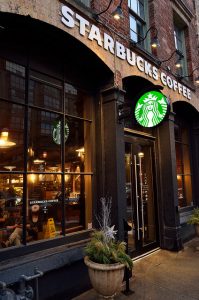
Following the arrest of two Black men at a Philadelphia Starbucks, public attention has increasingly focused on how race impacts whose presence in certain areas is questioned or not. The incident at Starbucks is part of a broader phenomenon about who we see as belonging or not-belonging in social settings and different spaces. Often, these perceptions — about who should and shouldn’t be at particular places — are rooted in race and racial difference.
Research shows that beliefs about belonging particularly affect how Black people are treated in America. Sociologist Elijah Anderson has written extensively about how certain social settings are cast as a “white space” or a “black space.” Often, these labels extend to public settings, including businesses, shopping malls, and parks. Labels like these are important because they can lead to differences in how some people are treated, like the exclusion of the two Black men from Starbucks.
- Anderson, Elijah. 2011. The Cosmopolitan Canopy: Race and Civility in Everyday Life. W.W. Norton & Company.
- Elijah Anderson. 2015. “The White Space.” Sociology of Race & Ethnicity 1(1): 10-21.
When addressing the intersections between race and social space, social scientists often focus on residential segregation, where certain neighborhoods are predominantly comprised of members of one racial group. While these dynamics have been studied since the mid 20th century, research shows that race is still an important factor in determining where people live and who their neighbors are — an effect compounded by the 2008 financial crisis and its impacts on housing.
- Jacob S Rugh, Len Albright, and Douglas S. Massey. 2015. “Race, Space, and Cumulative Disadvantage: A Case Study of the Subprime Lending Collapse.” Social Problems 62(2): 186-208.
- Matthew Hall, Kyle Crowder, and Amy Spring. 2015. “Neighborhood Foreclosures, Racial/Ethnic Transitions, and Residential Segregation.” American Sociological Review 80(3): 526-529.
- Ray Sin and Maria Krysan. 2015. “What Is Racial Residential Integration? A Research Synthesis, 1950–2013.” Sociology of Race and Ethnicity (1)4: 467-474.

Comments